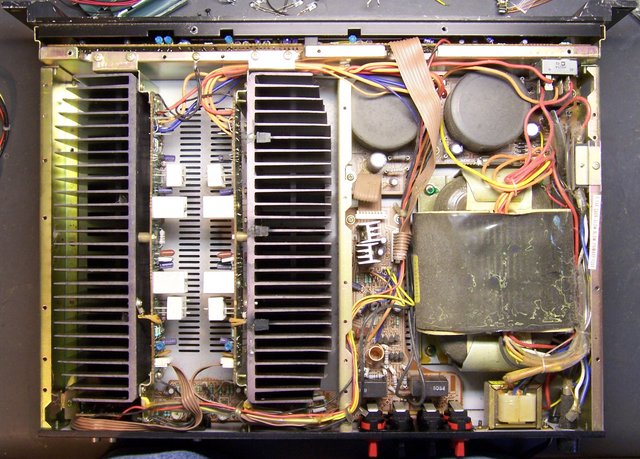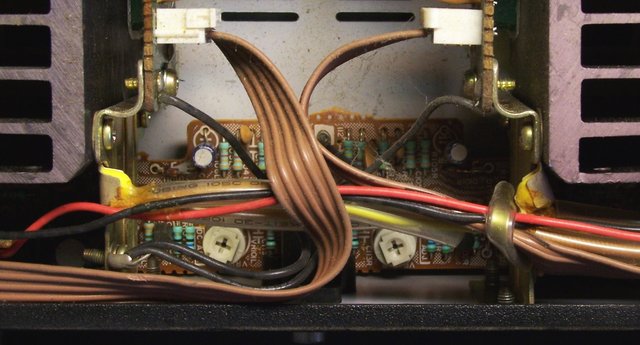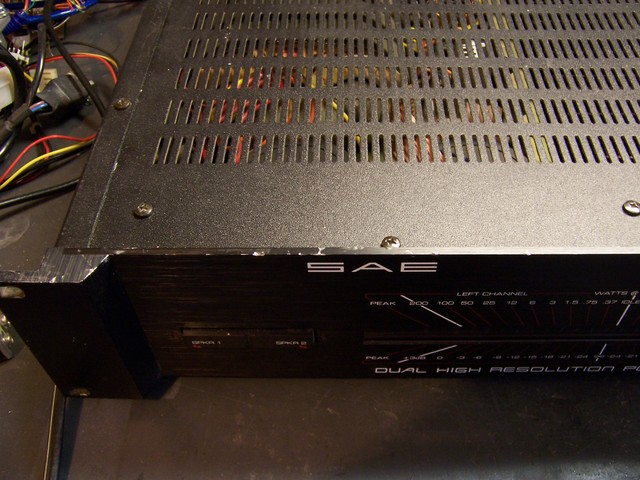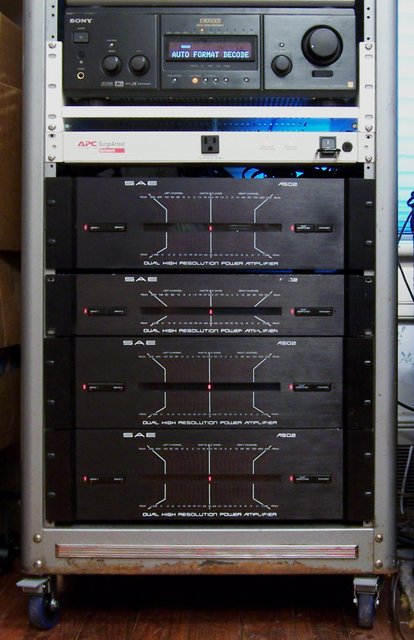As mentioned previously, I’m rather fond of SAE A502 amplifiers. Enough so that as I’m starting to think about biamping or triamping my system, I’ve started shopping for one or more A202 amps, the A502′s 100W little brother. And I found one on eBay, and it arrived this week.
Pop
I set it up in my stereo to drive the center channel speaker (for now), got everything connected, and turned it on. Pop. Turned it off. Pop. On. Pop. Speaker off. Pop. Speaker on. Pop. Amp off. Pop. No input signal at all, and pop pop pop.
SAE amplifiers don’t pop. They have relays specifically to keep startup and shutdown pops from making it to the speakers; so (I figured) I must have an unwanted DC component to my output. I ran this idea past Ron and he agreed that’s what was happening, so I measured the DC voltage at the speaker outputs with no input signal:
| Channel | DC Voltage | Channel | DC Voltage |
|---|---|---|---|
| Left | -.64V | Right | -.05V |
Huh. Looks like it’s time to adjust the DC offset.
Interestingly, I’m only using one amplifier channel for my center-channel speaker, and I happened to plug it into the left amp channel — the bad one. Had I plugged it into the right, I wouldn’t have noticed this problem for a long time, until I started using both channels. And that might have been when I set it up as a treble amp to drive tweeters, which might have blown out from the DC voltage. That would have made me cross.
DC Offset
Why is DC on a speaker output a bad thing? Well, each driver (the individual cone assemblies that mount in a box to form what we call a “speaker”) has an electromagnetic coil of wire in it. Current through the wire attracts and repels the back of the driver toward and away from a permanent magnet, causing the driver to move in and out, move air back and forth, and make sound.
The coil of wire also gets hot. The fine wire used in driver coils has a much higher resistance than the large wire between the amplifier and the speaker, so the coil is where the majority of the amplifier’s power is dissipated. Some of the amplifier’s electrical energy is turned into mechanical energy to move the driver, but much of it is turned into heat. Too much heat on a fine wire turns into a bad thing. And extra DC current doesn’t make sound; it just heats the wire.
Not much, to be sure. In my case,
.64V / 8Ω = .08A
.64V * .08A = .0512W
which isn’t much for my 150W speakers to handle. But it doesn’t do any good . . . and it pops when I turn the amp on and off.
This small DC output voltage comes about from an even smaller unwanted DC voltage in the preamplification stage, faithfully amplified through the power stage and delivered to the outputs. Because of imperfections in semiconductor manufacturing and the way preamplifiers are designed, this DC offset is virtually impossible to design out. Instead, preamp stages have a DC offset adjustment potentiometer, to adjust that particular preamp’s DC offset back to 0V (or very close).
Inside the A202
This morning I opened the A202 to make the adjustment. I was curious to see how much it looked like its big brother, and the answer is, not very much.
The power transformer is similar, and I recognize some other components and circuits, but the layout is completely different. This makes sense, given the smaller physical size of the A202, and its smaller power demands. The A202 is laid out asymmetrically, with power transistors on the amp’s right side (this picture is taken from the back, so our left) and the power supply on the amp’s left, rather than with the power supply sandwiched between two sets of power transistors.
The preamplification stage is on this smaller PCB located at the back of the amp between the large heatsinks. The DC offset pots are clearly visible and easy to get to at the back edge of the amp. (Thank you!)
The speaker terminals (barely visible in the upper picture) are an odd design, rather than standard binding posts, and my voltmeter probes aren’t quite long enough to make contact. So I inserted wires into the speaker terminals and used gator clips to connect to the voltmeter. I powered up the amp and carefully turned the pots until the DC output was as small as I was able to get it. I was disappointed that I couldn’t get the right channel all the way to 0V (on my meter), but 5mV isn’t bad.
| Channel | DC Voltage | Channel | DC Voltage | |
|---|---|---|---|---|
| Before Adjustment | Left | -.64V | Right | -.05V |
| After Adjustment | Left | .000V | Right | .005V |
I actually first made the adjustment with the amplifier cold, and then realized how silly that was. After letting it warm up for twenty minutes or so, one channel had already drifted up to .025V, so I was glad to have remembered to go back and fix it.
Cosmetics
Any time you perform service work, you should always clean whatever you’re servicing to the best of your ability; it makes a huge difference to the customer’s perception of your work (even if the customer is you). Ron cleans and polishes VCRs he repairs; good auto mechanics clean the entire area around whatever they’ve replaced (and run your car through a car wash if they’re really clever), and I wipe down cases of PCs I repair for friends and family.
This amp was no different. The inside was full of dust, so I took it to my brother’s house and used his air compressor to blow it out.
The outside was more interesting. I don’t know what the former owner did with this amp, but the case looks like it had a fight with a parking lot and lost. Lots of dings, nicks, and scrapes.
I felt around the edge of the front panel for any dings with sharp edges, and carefully filed them flush with a fine file. Then I use a black permanent marker to fill in every shiny spot. It’s not a perfect match for the original finish and you can easily tell the difference from up close — but you can’t tell the difference from across the room in a normal listening position, and that’s well worth the effort.
About half of the model number on the front panel is scraped off, and I’m not sure how to repair that. It’s white (or near-white) paint, probably silk-screened on, and I think I’m more likely to make a mess than an improvement. I’d welcome experienced suggestions on how to touch that up.
Putting It All Together
I reassembled the amp and reinstalled it, and the popping sound is gone. Even with my ear directly in front of the speaker, I don’t hear any noise there — just the relay clicking in the amp itself.
Here’s what my stack looks like now. It’s in an old PA cabinet on which I mounted soft-wheeled castors for convenience and to protect my softwood floor. The cabinet has rack rails, but the amps aren’t mounted — just stacked. I need to get nylon shoulder washers to protect the amps’ front-panel finish before I’m willing to rackmount them.
From top to bottom,
- my Sony surround processor / preamp sitting on a rack shelf
- a rackmount, surge-protected power strip (love this!)
- my original A502 amp, running the main speakers
- the A202, running the center speaker
- the A502 with replaced relay, running the rear speakers
- another A502 that I bought working, running the subwoofer
I have two more broken A502s waiting to be repaired, plus a couple of other related projects, so there should hopefully be more along these lines soon.




hi, i have a sony explode 760 watt amp. and its not pushing my subs due to an offset problem. all i know is the amp is reading offset. what do i do??
Christopher, find a service manual or schematic for the amp, let it warm up, and zero the offset adjustment.
Hi, just wondering what you take is on the quality of the SAE 02 series versus the older 00 and 01 amps? What would you say the pros and cons are? Reading the specs it seems the distortion levels have decreased from 0.05% of early models to 0.025% on the a202.
Thanks
Martin, I’m not well informed on this, as I’ve only ever had 02 equipment. I know there are people who are huge fans of some of the older, lower-powered equipment, but I can’t comment on that directly.
I’ll just say that I really like the higher-powered equipment I own, and that a recording-studio-owning and professional A/V repair friend of mine was impressed with how overbuilt they are. He commented in particular about how many more watts of output the power rails could provide than the power rating SAE chose to write on the back of the case.
I’ve got an SAE Mark III amp (one of the very original ones, 120 WPC) that has a 140 mV DC offset in one channel, which is on the edge of “too high.” There’s no DC offset adjustment. I have the circuit diagram and am not sure where to start (because there are no normative voltages to compare).
Ideas? Pointers?
Thanks in advance.
David, if you want to email me the schematic, I’d be interested in having a look at it and seeing whether I could suggest anything helpful.
Keith,
I have an A202 and a P102 that I have been using for years (original owner) and I love them. The other day the 6 amp fuse on the A202 blew and when I replaced it on turned it on “Hummm” then blew the fuse again. I have been having trouble finding a schematic. Can you help.
Bob
Bob, I’m sorry to give you bad news, but I’ve never been able to locate a schematic for the A202 either. It wouldn’t hurt to check that the power supply filter capacitors are still good, but beyond that I’d really want to look at the circuit.
The only SAE equipment that is worth owning is the mark series
or 2000 line.The 01 and 02 line are garbage and most top-end techs
avoid them like the plague.
Les, you’re welcome to share your opinions here — but they’ll be taken a lot more seriously if you back them up with objective data rather than make grumpy remarks and flee. Don’t cite authority; tell us what it is that makes the Mark and 2000 series so much better. More power? Better S/N? Longer MTBF?
Getting back to Keith’s problem — blown fuse. Sorry if the explanation below is super basic, but maybe there’s something new in it. Bottom line, I work on amps all the time without a schematic, as the failure mode for discrete components is so straightforward. When it comes to integrated circuit amps, things get cloudier.
While it’s possible the problem is the main electrolytics — and that’s nice because a short is so easily checked — it’s just as likely to be a shorted output transistor or two.
If you find ONE shorted transistor in the output stage, you’re likely to find more (as the short passes unregulated voltage all over the place). Even if there are no shorted transistors in the final stage, check the drivers anyway.
You don’t need any fancy equipment: just an ohm meter…but you do have to remove the transistors from the circuit to get reliable readings. The readings don’t have to be a complete short — all they have to be is “no more diode” (resistance reads the same both polarities) to cause trouble.
If you need service info/schematics for SAE equipment check Jim’s SAE site. Simply send him a email request and he will send you the info. He is very helpful when it comes to supplying info on SAE Audio. Here is the link to the list of service docs he has:
http://www.jims-sae-site.com/manual_schematics.htm
Take care,
John.
i just bought a sae a 202 for ten dollars and im trying to hook it up to my home stero because i wamt more bass the home stero is a technics receiver with a sony 5 disk cd player and the sae 202 amd i try to use the rca jacks and the only thing it does is come on full blast could u please tell me how to hook it up so i can have volume controll
Jason, you’ll need a separate preamplifier to plug between your stereo’s line outs and the amplifier or an “impedance converter” (may go by other names) to connect between the stereo’s speaker outs and the amplifier.
I’d recommend changing out to a separate preamp, because you’re probably already missing the bass by the time you get out the speaker outputs and the SAE amp won’t put it back in.
Hi Keith: I have a dusty old A202 that plays fine but heats up badly causing the caps to become noisy. The bias adjustment is clearly labeled. Do you know the test points and the correct reading? I measured the DC offset at 150 mV and 50 mV respectively, which is too high. The DC offset trimmers do not seem to have an effect on these figures. Any ideas and advice would be greatly appreciated. Thanks, Sam.
Sam, if the offset trimmers aren’t working, I don’t know what to suggest!
I just emailed Jim at Jim’s SAE site to see about buying a copy of his A202 service manual. If it has schematics, I’ll have a look and see whether that generates any new ideas.
Hi Keith,
I have Classe Model 20 pre-amp which has been coupled with Marantz MA500 Mono-blocks. Recently while listening to music, the pre-amp went into protection mode while green led indicator was blinking. I immediately switched it off and allowed it to rest for some time. Also, I checked the associated equipment and cables, I did not find any faults.
After a long rest, the Classe pre-amp was switched on again, It started to work normally for 4-5 minutes and later again went into protection mode. However, the green led light indicator was continuously blinking without the amp getting into steady state.
I contacted the Classe Canada, they informed me that this abnormal behavior of the amp was more likely to be due to DC offset.
Kindly let me know how I should get over the problem. Classe was nice enough to send me the schematics for the discontinued Classe Model 20.
If you want the schematics, how can I upload it to you for your kind perusal.
Cheers
I bought a A502 from a second hand shop and it would not fire up. Long story short, I replaced a transistor and a resistor in the safety circuit. Seems the resistor value that is published in the schematics I have is wrong too and I read a lot of people do repeat repairs because of it. I also saw oily residue all over the amp so I figured the caps were done after 30 years. I did a full recap and replaced 52 caps in total, including the main caps. The amp lives again. I have the schematics but I do not have any of the procedures used to calibrate the amp. I looked at your A202 post regarding DC offset and observed 4mv of offset on my amp. The strange thing is if I move the pot to adjust offset it increases and then settles back down to 4mv no matter what position the pot is in. It is almost as though this thing is auto adjusting back down to 4mv. I see there are test hoops soldered onto the main board. I imagine there is a formal procedure to align this amp. Do you have the documented procedures?
Is the SAE A202 considered a 2 channel amp or 4 channel amp?
If 2 channel amp that would be 100w x 2 right?
If 4 channel amp that would be 100w x 4 right?
Hello,
Was gifted a second hand A202 that I used with some smaller dj speakers. The sound, to me, was fantastic. One day I was using it and volume just cut off completely. A relative took it to get repaired, and it came back with the same problem. Unit powers up, clicks when making channel selection, and meter responds to input sound, but no sound coming out.
Do you think this could be a blown transformer, a malfunction of the relay function mentioned in the top post, or a dc issue? Would it be super expensive to get this repaired?
Thank you
Brian, I believe the click on channel selection is the relay. I suspect a problem in the power amp stage. A service tech experienced in component-level repair of transistor circuits should be able to fix this for you … and of course, they’re getting harder to find.
I just acquired a SAE P102 pre amp & a AES AS02 Amp. I have a receiver and I can get the pre amp to acquire the signal and the bars move up & down, but I cannot get the speaker to put out any sound. The middle light and the 2 speaker lights come on the AS02 fine (comes out of standby mode). Could a fuse still be blown (it is ceramic and I am new to amps- cant see if its blown). Also wondering why a small plastic piece is preventing the unit from being taken out of stereo mode also. Any help would be appreciated.
Hello. Maybe someone can shed some light on a issue here. I have a full SAE rack system. Two 502 amps running in mono mode. Recently one of the led displays is only reading one direction. Bad connector? I haven’t been in it yet. Why I ask.
Thanks in advance. David